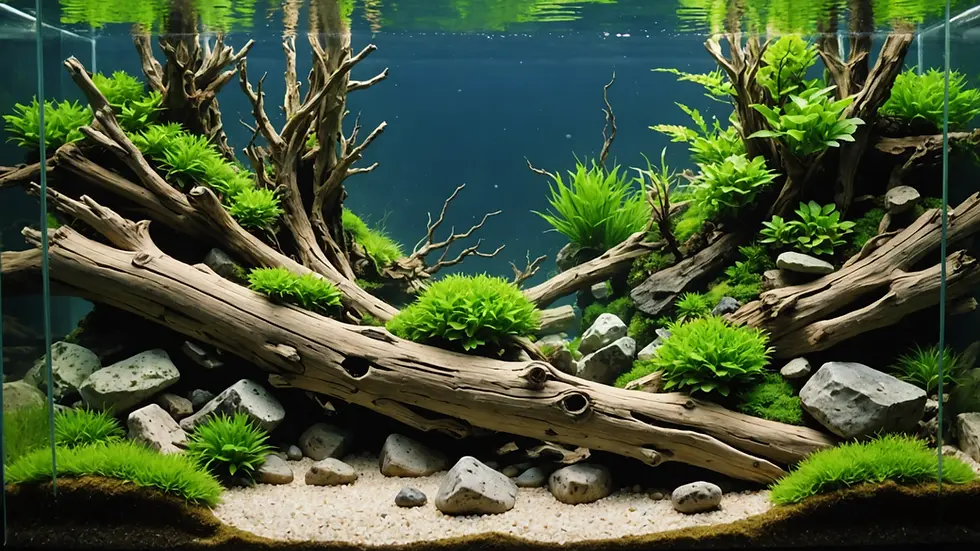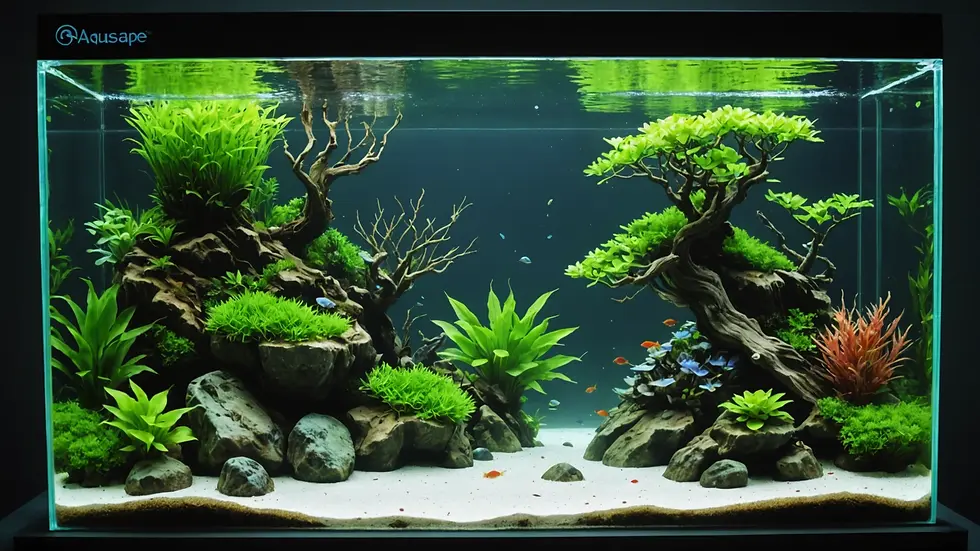How to Start Your Aquascaping Journey: A Beginner's Guide
- Jyotiraj Borah
- Feb 8
- 5 min read
Aquascaping is an exciting blend of art and science that lets you create beautiful underwater landscapes in your aquarium. If you’re new to this hobby, getting started can feel both thrilling and complex. But don’t worry; this guide will provide the essential information you need for a rewarding aquascaping experience. From setup to plant care, we cover everything a beginner should know.
Understanding Aquascaping
Aquascaping is all about designing and caring for aquatic landscapes by arranging plants, rocks, and other natural materials to create stunning visuals. It's not just a decorative hobby; it also promotes a healthy habitat for fish and aquatic life.
To successfully start aquascaping, you need to recognize the balance of natural elements involved. Just like a garden, an aquascape requires the right mix of light, carbon dioxide, and nutrients. According to research, aquariums with proper lighting and nutrient balance can increase plant growth by up to 50%. This creates an environment that replicates a real ecosystem.
Essential Equipment
Creating your aquascape requires specific tools. Having the right equipment can make the entire process smoother. Here’s an essential list to get you started:
Aquarium: Choose a size that fits your space. A 20-gallon tank is a great starting point for beginners.
Substrate: This material sits at the bottom of your aquarium. Nutrient-rich soil encourages plant growth, while sand or gravel can be used for aesthetic purposes.
Plants: Select a variety of plants, such as Anubias for the foreground, Java Fern for mid-ground, and Vallisneria for the background to create depth.
Hardscape materials: Include rocks or driftwood to give structure. For instance, using stone types like Seiryu or dragon stone can add character.
Water conditioner: Essential for making tap water safe by removing harmful chemicals.
Light Source: LED lights support plant growth and produce less heat than traditional bulbs.
Filtration system: A good filter is vital for ensuring clean and healthy water, which is crucial for both plants and fish.
Investing in quality gear can significantly enhance your aquascaping experience.
Setting Up Your Aquarium
After gathering your materials, you're ready to set up your aquarium. Follow these steps for an effective installation:
1. Cleaning the Aquarium
Start by thoroughly cleaning your aquarium. Wash it with fresh water, ensuring no dust or residues remain.
2. Adding Substrate
Pour your selected substrate into the tank to create an even base. You can vary the height in specific areas, which adds visual interest and depth.
3. Designing the Hardscape
Arrange your rocks and driftwood in the aquarium. Use the rule of thirds; placing focal points off-center creates a balanced layout. For example, positioning a large piece of driftwood on one side allows for more visual flow.

4. Planting
It's time to add plants. Start with taller varieties in the back and gradually move to shorter plants in the front. Ensure you bury the roots securely to promote healthy growth.
5. Filling with Water
Fill the aquarium carefully to avoid disturbing the substrate and hardscape. You can place a plate on the bottom and pour water over it to minimize disruption.
6. Conditioning
Use a water conditioner to treat the water, eliminating chlorine and harmful substances. This step is crucial before adding any fish or sensitive plants.
Lighting and Maintenance
Proper lighting is key for successful aquascaping. Aim for around 8-10 hours of light daily. Adjust the height and intensity of your lights based on your plant selection; for instance, low-light plants like Anubias thrive under softer lighting, while high-light plants like Rotala may require brighter conditions.
Regular maintenance is essential for a healthy aquarium. Aim for weekly water changes of about 10-20%. Routine pruning of dead leaves and trimming overgrown plants keeps your aquascape balanced and thriving.
Choosing Aquatic Life
Introducing fish and other aquatic creatures brings your creation to life. Different species have unique requirements, so research compatibility before adding any.
1. Choosing Fish
Begin with smaller species that fit well in your aquascape. Here are three excellent options for beginners:
Betta Fish: Known for their vibrant colors and easy care requirements.
Tetras: Generally peaceful and enjoy being in groups.
Guppies: Hardy and colorful, they adapt well to various conditions.
2. Adding Invertebrates
Incorporate shrimp or snails to enhance your aquarium's cleanliness. Cherry shrimp and nerite snails are popular choices known for their low maintenance and effectiveness at algae control.
Common Challenges and How to Tackle Them
Every new aquarist may face challenges. Here are some common issues and solutions:
Algae Growth
Unwanted algae can spoil your aquascape's appearance. To reduce algae, manage your lighting duration and introduce algae-eating creatures. Additionally, a simple routine of wiping down tank walls and checking nutrient levels can keep algae at bay.
Water Quality Issues
Routine water testing is crucial. Invest in test kits to monitor pH, ammonia, nitrites, and nitrates. Aim for a pH between 6.5 and 7.5 for most freshwater fish, and make necessary adjustments.
Plant Growth Problems
If your plants struggle, they might be lacking nutrients or light. Consider adding fertilizers specifically designed for the plant species you have chosen to boost their growth.
Aquascaping Styles
Explore various aquascaping styles to choose one that resonates with your vision:
1. Nature Aquarium Style
This style mimics natural landscapes, emphasizing harmony between plants, rocks, and wood to create a lifelike scene.
2. Dutch Style
Focused on colorful plant arrangements, this style features diverse plant species with varying heights and hues for striking visuals.
3. Iwagumi Style
This minimalist style revolves around a few rocks, stressing clean lines and balance, making it visually appealing with less clutter.
Continuing Your Education
Continuous learning is vital for success in aquascaping. As techniques and practices evolve, keep yourself updated.
Online Resources
Leverage forums, blogs, and YouTube channels dedicated to aquascaping for inspiration. These platforms provide access to ideas, troubleshooting tips, and community engagement.
Books and Magazines
Investing in books by aquascaping experts can deepen your understanding of design principles and best practices. Many offer insights on common challenges and how to overcome them.
Embrace Your Aquascaping Adventure
Aquascaping is a fulfilling hobby that fosters creativity while nurturing aquatic life. By mastering the essential elements—from equipment selection to aquarium maintenance—you can create breathtaking landscapes that enhance your space.
As you embark on this journey, remember that patience is key. Mastery takes time, and every aquascape has its unique personality. Enjoy the experience, celebrate your achievements, and learn from the hiccups along the way.
Happy aquascaping!

Dive into the world of aquascaping, where every small step brings you closer to tranquility and creativity.




Comments